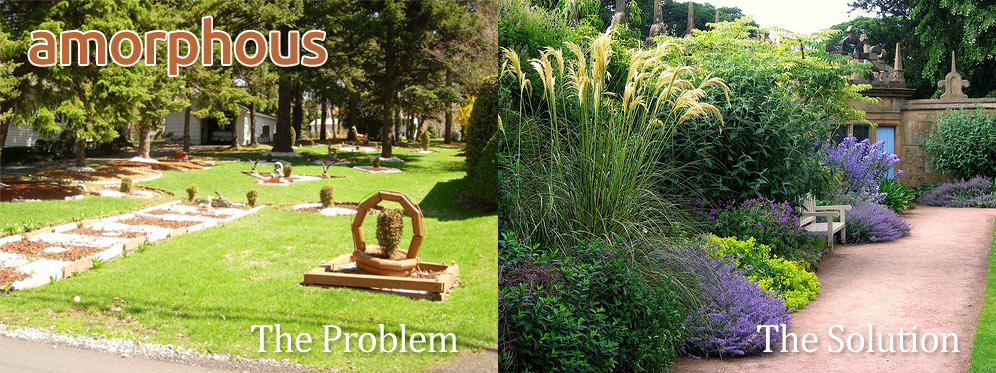a·mor·phous
–adjective.
- lacking definite form; having no specific shape; formless: the amorphous clouds
- of no particular kind or character; indeterminate; having no pattern or structure; unorganized: an amorphous style; an amorphous personality.
The Problem
In our field, amorphous is a ‘nails on the chalkboard’ kinda word. Just as I explained in an earlier post, anyone can go to Home Depot and buy a bunch plants and dig a few holes. The same applies to the shapes you create around your property. But the ‘have shovel, will create bed-edges’ theory creates more of a mess than one could imagine, and falls far short of satisfactory in the end. Many times, bed edges are arbitrarily created. The end result is a series of curves that have no relationship to existing geometry (such as adjacent buildings, the existing plantings they’ll encompass, property lines, etc.), or to other curving bed edges nearby.
The Solution
When creating planting beds in the landscape, care should be given to their shape and size. Having a plan that shows the ‘top’ view of your property is where we begin. This allows you to see every element that relates to the bed you’re creating. Some things to keep in mind:
Create gentle, sweeping curves. A radius of 5′ or more is sufficient where possible. This allows a lawn mower to easily follow the edge without having to stop and abruptly change directions.
Keep bed edges beyond (outside) the canopy of any tree within it. This ensures that the root system remains undamaged, as they usually extend from the trunk as much as the canopy does.
Only make a curve if it makes sense to make a curve. Making curves for the sake of making curves gives the impression you’re trying too hard to be artistic. Sometimes a straight line is all that’s needed to create an effective edge, even in a garden that is meant to look more natural than formal. Just let the eventually overflowing plants create the curving edge for you, if you wish.
Proportion is also an important characteristic not to be overlooked. It is better to have one larger bed than many smaller ones. This will establish continuity, and allow those curves to be larger and more gradual. This also allows you to inter plant some understory specimens in between those six or seven larger canopy trees that originally only had smaller tree rings around the trunks. Imagine the time (and gasoline, AND MONEY) saved from mowing and trimming around each trunk!!
Don’t be afraid to make a bold statement. Larger beds will allow the plants to grow without much need for pruning maintenance, as they will have the room to reach out to their mature sizes. Be patient, the planting beds that may seem sparsely planted in their first season will continue to become fuller over time, and you’ll notice a consistent reduction in the amount of mulch you’re buying each year as a result.
Obviously, there are exceptions to every rule, especially in a field that works with nature. But these guidelines will provide a great point to begin. If this seems a bit overwhelming, don’t hesitate to consult a design professional for some guidance. Most designers will abide by some variation of the above guidelines, and little free advice can go a long way.
See you soon..


Recent Comments